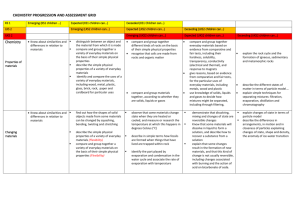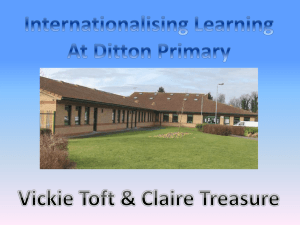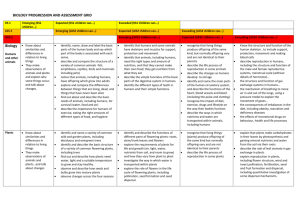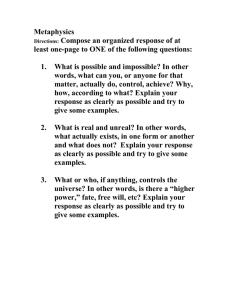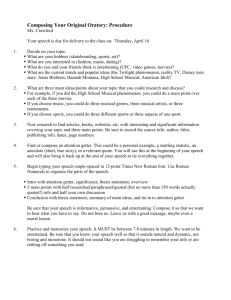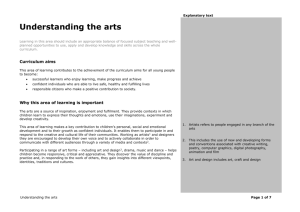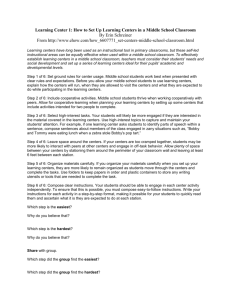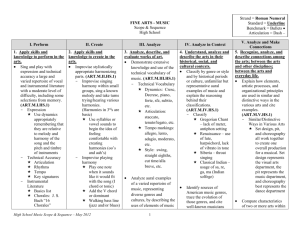Expressive Art and Design - imaginative
advertisement
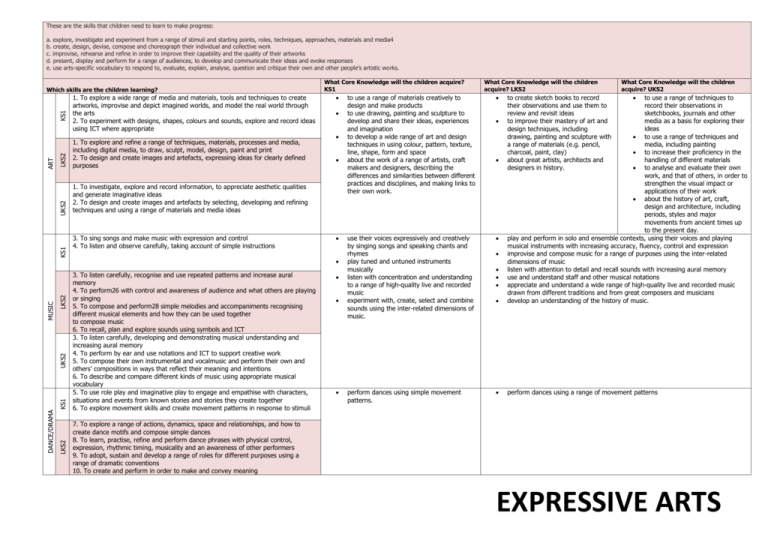
These are the skills that children need to learn to make progress: a. explore, investigate and experiment from a range of stimuli and starting points, roles, techniques, approaches, materials and media4 b. create, design, devise, compose and choreograph their individual and collective work c. improvise, rehearse and refine in order to improve their capability and the quality of their artworks d. present, display and perform for a range of audiences, to develop and communicate their ideas and evoke responses e. use arts-specific vocabulary to respond to, evaluate, explain, analyse, question and critique their own and other people’s artistic works. LKS2 UKS2 1. To investigate, explore and record information, to appreciate aesthetic qualities and generate imaginative ideas 2. To design and create images and artefacts by selecting, developing and refining techniques and using a range of materials and media ideas LKS2 LKS2 KS1 UKS2 MUSIC DANCE/DRAMA 1. To explore a wide range of media and materials, tools and techniques to create artworks, improvise and depict imagined worlds, and model the real world through the arts 2. To experiment with designs, shapes, colours and sounds, explore and record ideas using ICT where appropriate 1. To explore and refine a range of techniques, materials, processes and media, including digital media, to draw, sculpt, model, design, paint and print 2. To design and create images and artefacts, expressing ideas for clearly defined purposes KS1 ART KS1 Which skills are the children learning? 3. To sing songs and make music with expression and control 4. To listen and observe carefully, taking account of simple instructions What Core Knowledge will the children acquire? KS1 3. To listen carefully, recognise and use repeated patterns and increase aural memory 4. To perform26 with control and awareness of audience and what others are playing or singing 5. To compose and perform28 simple melodies and accompaniments recognising different musical elements and how they can be used together to compose music 6. To recall, plan and explore sounds using symbols and ICT 3. To listen carefully, developing and demonstrating musical understanding and increasing aural memory 4. To perform by ear and use notations and ICT to support creative work 5. To compose their own instrumental and vocalmusic and perform their own and others’ compositions in ways that reflect their meaning and intentions 6. To describe and compare different kinds of music using appropriate musical vocabulary 5. To use role play and imaginative play to engage and empathise with characters, situations and events from known stories and stories they create together 6. To explore movement skills and create movement patterns in response to stimuli What Core Knowledge will the children acquire? LKS2 What Core Knowledge will the children acquire? UKS2 to use a range of materials creatively to design and make products to use drawing, painting and sculpture to develop and share their ideas, experiences and imagination to develop a wide range of art and design techniques in using colour, pattern, texture, line, shape, form and space about the work of a range of artists, craft makers and designers, describing the differences and similarities between different practices and disciplines, and making links to their own work. use their voices expressively and creatively by singing songs and speaking chants and rhymes play tuned and untuned instruments musically listen with concentration and understanding to a range of high-quality live and recorded music experiment with, create, select and combine sounds using the inter-related dimensions of music. to use a range of techniques to record their observations in sketchbooks, journals and other media as a basis for exploring their ideas to use a range of techniques and media, including painting to increase their proficiency in the handling of different materials to analyse and evaluate their own work, and that of others, in order to strengthen the visual impact or applications of their work about the history of art, craft, design and architecture, including periods, styles and major movements from ancient times up to the present day. play and perform in solo and ensemble contexts, using their voices and playing musical instruments with increasing accuracy, fluency, control and expression improvise and compose music for a range of purposes using the inter-related dimensions of music listen with attention to detail and recall sounds with increasing aural memory use and understand staff and other musical notations appreciate and understand a wide range of high-quality live and recorded music drawn from different traditions and from great composers and musicians develop an understanding of the history of music. perform dances using simple movement patterns. perform dances using a range of movement patterns to create sketch books to record their observations and use them to review and revisit ideas to improve their mastery of art and design techniques, including drawing, painting and sculpture with a range of materials (e.g. pencil, charcoal, paint, clay) about great artists, architects and designers in history. 7. To explore a range of actions, dynamics, space and relationships, and how to create dance motifs and compose simple dances 8. To learn, practise, refine and perform dance phrases with physical control, expression, rhythmic timing, musicality and an awareness of other performers 9. To adopt, sustain and develop a range of roles for different purposes using a range of dramatic conventions 10. To create and perform in order to make and convey meaning EXPRESSIVE ARTS UKS2 7. To draw upon different dance styles to compose dances and communicate meaning 8. To develop and refine their movement repertoire and show understanding of artistic meanings and intentions when they dance 9. To create roles and devise performances that sustain characters, plots and intentions 10. How facial expressions, body language, movement and space can communicate different emotions and characteristics of behaviour 11. To select and experiment with a broad range of drama conventions and forms for different purposes and effects How will the children be enabled to do this? ‘Breadth of Learning’ During the year, pupils should be taught the knowledge, skills and understanding through: a. practical activity, exploration and discussion b. using mathematical ideas in practical activities, then recording these using objects, pictures, diagrams, words, numbers and symbols c. using mental images of numbers and their relationships to support the development of mental calculation strategies d. estimating, drawing and measuring in a range of practical contexts e. drawing inferences from data in practical activities f. exploring and using a variety of resources and materials, including ICT g. activities that encourage them to make connections between number work and other aspects of their work in mathematics. EXPRESSIVE ARTS
